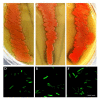Bacterial Symbionts in Ceratitis capitata
- PMID: 35621808
- PMCID: PMC9147879
- DOI: 10.3390/insects13050474
Bacterial Symbionts in Ceratitis capitata
Abstract
Ceratitis capitata (Diptera: Tephritidae) is responsible for extensive damage in agriculture with important economic losses. Several strategies have been proposed to control this insect pest including insecticides and the Sterile Insect Technique. Traditional control methods should be implemented by innovative tools, among which those based on insect symbionts seem very promising. Our study aimed to investigate, through the 16S Miseq analysis, the microbial communities associated with selected organs in three different medfly populations to identify possible candidates to develop symbiont-based control approaches. Our results confirm that Klebsiella and Providencia are the dominant bacteria in guts, while a more diversified microbial community has been detected in reproductive organs. Concertedly, we revealed for the first time the presence of Chroococcidiopsis and Propionibacterium as stable components of the medfly's microbiota. Additionally, in the reproductive organs, we detected Asaia, a bacterium already proposed as a tool in the Symbiotic Control of Vector-Borne Diseases. A strain of Asaia, genetically modified to produce a green fluorescent protein, was used to ascertain the ability of Asaia to colonize specific organs of C. capitata. Our study lays the foundation for the development of control methods for C. capitata based on the use of symbiont bacteria.
Keywords: Asaia; Ceratitis capitata; Symbiotic Control.
Conflict of interest statement
The authors declare no conflict of interest.
Figures




Similar articles
-
Phylogenomics Reveals that Asaia Symbionts from Insects Underwent Convergent Genome Reduction, Preserving an Insecticide-Degrading Gene.mBio. 2021 Mar 30;12(2):e00106-21. doi: 10.1128/mBio.00106-21. mBio. 2021. PMID: 33785632 Free PMC article.
-
Characterization of the microbial communities in Tunisian wild populations of the Mediterranean fruit fly (Ceratitis capitata) and their implications for the future implementation of the sterile insect technique.Insect Sci. 2025 Mar 18. doi: 10.1111/1744-7917.70016. Online ahead of print. Insect Sci. 2025. PMID: 40098416
-
Manipulation of the microbiota of mass-reared Mediterranean fruit flies Ceratitis capitata (Diptera: Tephritidae) improves sterile male sexual performance.ISME J. 2010 Jan;4(1):28-37. doi: 10.1038/ismej.2009.82. Epub 2009 Jul 16. ISME J. 2010. PMID: 19617877
-
Bacteria of the genus Asaia: a potential paratransgenic weapon against malaria.Adv Exp Med Biol. 2008;627:49-59. doi: 10.1007/978-0-387-78225-6_4. Adv Exp Med Biol. 2008. PMID: 18510013 Review.
-
Tephritidae bacterial symbionts: potentials for pest management.Bull Entomol Res. 2020 Feb;110(1):1-14. doi: 10.1017/S0007485319000403. Epub 2019 Jun 21. Bull Entomol Res. 2020. PMID: 31223102 Review.
Cited by
-
Special Issue: Selected Papers from the 1st International Electronic Conference on Entomology.Insects. 2022 Oct 18;13(10):945. doi: 10.3390/insects13100945. Insects. 2022. PMID: 36292892 Free PMC article.
-
Effect of Wolbachia Infection and Adult Food on the Sexual Signaling of Males of the Mediterranean Fruit Fly Ceratitis capitata.Insects. 2022 Aug 17;13(8):737. doi: 10.3390/insects13080737. Insects. 2022. PMID: 36005362 Free PMC article.
-
Effects of species and sex on the gut microbiome of four laboratory-reared fruit fly lines (Diptera: Tephritidae) using full-length 16S rRNA PacBio Kinnex sequencing.BMC Microbiol. 2025 Jul 28;25(1):455. doi: 10.1186/s12866-025-04025-0. BMC Microbiol. 2025. PMID: 40721996 Free PMC article.
-
Gut bacterial population and community dynamics following adult emergence in pest tephritid fruit flies.Sci Rep. 2023 Aug 22;13(1):13723. doi: 10.1038/s41598-023-40562-2. Sci Rep. 2023. PMID: 37607978 Free PMC article.
-
Probiotic consortium modulating the gut microbiota composition and function of sterile Mediterranean fruit flies.Sci Rep. 2024 Jan 11;14(1):1058. doi: 10.1038/s41598-023-50679-z. Sci Rep. 2024. PMID: 38212383 Free PMC article.
References
-
- White I.M., Elson-Harris M.M. Fruit Flies of Economic Significance: Their Identification and Bionomics. CABI Publishing; Wallingford, UK: 1992.
-
- Plá I., García de Oteyza J., Tur C., Martínez M., Laurín M.C., Alonso E., Martínez M., Martín Á., Sanchis R., Navarro M.C., et al. Sterile Insect Technique Programme against Mediterranean Fruit Fly in the Valencian Community (Spain) Insects. 2021;12:415. doi: 10.3390/insects12050415. - DOI - PMC - PubMed
-
- Vreysen M.J.B., Abd-Alla A.M.M., Bourtzis K., Bouyer J., Caceres C., de Beer C., Oliveira Carvalho D., Maiga H., Mamai W., Nikolouli K., et al. The Insect Pest Control Laboratory of the Joint FAO/IAEA Programme: Ten Years (2010–2020) of Research and Development, Achievements and Challenges in Support of the Sterile Insect Technique. Insects. 2021;12:346. doi: 10.3390/insects12040346. - DOI - PMC - PubMed
-
- Utarini A., Indriani C., Ahmad R.A., Tantowijoyo W., Arguni E., Ansari M.R., Supriyati E., Wardana D.S., Meitika Y., Ernesia I., et al. Efficacy of Wolbachia-Infected Mosquito Deployments for the Control of Dengue. N. Engl. J. Med. 2021;384:2177–2186. doi: 10.1056/NEJMoa2030243. - DOI - PMC - PubMed
Grants and funding
LinkOut - more resources
Full Text Sources

